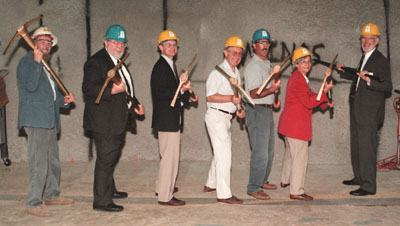
Deep in a former Minnesota iron mine, scientists and government officials recently wielded pickaxes to chip away, at least symbolically, at the mysteries surrounding the subatomic particles known as neutrinos.
The miners-for-a-day in the Soudan mine took the first steps in carving out a huge cavern, half a mile underground, that will become home to a 5000 ton particle detector. Physicists of the 200-member Main Injector Neutrino Oscillation Search (MINOS) experiment will use the detector to explore the question of neutrino mass.
Physicists once believed that neutrinos were massless, zipping through matter at the speed of light. However, recent results suggested that these elusive particles have a small mass. Even a tiny neutrino mass would have major consequences for our understanding of the nature and distribution of mass in the universe.
The MINOS experiment could detect not only the disappearance of muon neutrinos, but eventually their appearance as neutrinos of a different type tau neutrinos.
For the MINOS experiment, 120 GeV protons from Fermilab’s newly commissioned Main Injector accelerator will be used to generate an intense beam of muon neutrinos directed towards the underground Soudan detector, 730 km away. Neutrinos are reluctant to interact with matter and can pass through the Earth without any effect. However, interaction is probability not zero, so an intense beam and/or a large detector will record some interactions.
From early 2003, MINOS collaborators will use the detector to determine whether some of the muon neutrinos in the beam have changed to another type, known as tau neutrinos. Such a change, or oscillation from one type to another, would constitute clear evidence of neutrino mass and would allow physicists to begin to calculate just how much mass the particles possess. Locating the detector far below ground screens out cosmic rays that would otherwise flood the detector with irrelevant signals.
Earlier neutrino experiments detected fewer naturally-occurring neutrinos than expected, so they concluded that one type of neutrino had oscillated into another and, hence, had “disappeared” from detection. In contrast, the MINOS experiment could detect not only the disappearance of muon neutrinos, but eventually their appearance as neutrinos of a different type tau neutrinos.
To monitor the evolution of the neutrino beam, MINOS will use two detectors the “near detector” at Fermilab and the 5400 tonne “far detector” in the Soudan tunnel. The design initially proposed foresees fine-grained iron-scintillator sandwich calorimeters providing both tracking and energy deposition information.
On the other side of the Pacific Ocean is a similar study K2K using neutrinos provided by the accelerator at the Japanese KEK Laboratory in Tsukuba. The particles are directed towards the Super-Kamiokande underground detector 250 km away. K2K is recording its first data.
At CERN, physicists are studying a proposal to direct a neutrino beam towards the Italian Gran Sasso underground laboratory. Curiously, like MINOS, it is 730 km from the accelerator neutrino source.








